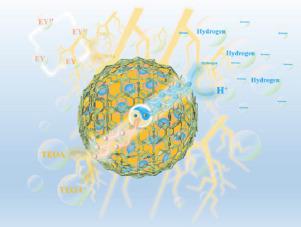当前位置:
X-MOL 学术
›
Chin. J. Catal.
›
论文详情
Our official English website, www.x-mol.net, welcomes your feedback! (Note: you will need to create a separate account there.)
Anchoring oxidation co-catalyst over CuMn2O4/graphdiyne S-scheme heterojunction to promote eosin-sensitized photocatalytic hydrogen evolution
Chinese Journal of Catalysis ( IF 16.5 ) Pub Date : 2024-01-10 , DOI: 10.1016/s1872-2067(23)64563-2 Cheng Yang , Xin Li , Mei Li , Guijie Liang , Zhiliang Jin
Chinese Journal of Catalysis ( IF 16.5 ) Pub Date : 2024-01-10 , DOI: 10.1016/s1872-2067(23)64563-2 Cheng Yang , Xin Li , Mei Li , Guijie Liang , Zhiliang Jin

|
It is widely acknowledged that efficient charge separation and utilization of photocatalysts are key factors in determing the photocatalytic hydrogen production. Construction of heterojunction has been considered as a promising way to efficiently solve the spatial separation of photogenerated charges. In addition, the introduction of proper cocatalysts can realize the separation of electrons and holes of the photocatalyst and enhance the photocatalytic performance by promoting more carriers to flow to the corresponding active sites. Herein, the S-scheme heterojunction was constructed by introducing graphdiyne into CuMnO for photocatalytic hydrogen evolution. Graphdiyne as a reduction semiconductor and in situ produced MnO from CuMnO as an oxidation cocatalyst to promote the precisely migration of photogenerated electrons and holes to the corresponding reduction and oxidation sites of photocatalyst. Notably, the photocatalytic performance of the 600-CuMnO/GDY-40% (6-CG-40) could reach 1586.54 μmol g h, which is 13.86 and 21.48 times higher than those of CuMnO (106.73 μmol g h) and graphdiyne (70.57 μmol g h), respectively. Theoretical calculations and experiments results show that both induced growth of MnO oxidation co-catalyst and the introduction of to construct S-scheme heterojunction efficiently suppress the severe recombination of photogenerated electron-hole pairs, thus optimizing the photogenerated carrier transfer efficiency, and ultimately leading to the enhanced eosin Y-sensitized photocatalytic hydrogen evolution activity. This work provides a promising method for the construction of oxidation cocatalyst engineered S-scheme heterojunction for solar water splitting.
中文翻译:

CuMn2O4/石墨二炔S型异质结上的锚定氧化助催化剂促进曙红敏化光催化析氢
更新日期:2024-01-10
中文翻译:

CuMn2O4/石墨二炔S型异质结上的锚定氧化助催化剂促进曙红敏化光催化析氢
人们普遍认为,光催化剂的有效电荷分离和利用是决定光催化制氢的关键因素。异质结的构建被认为是有效解决光生电荷空间分离的有前途的方法。此外,引入合适的助催化剂可以实现光催化剂电子和空穴的分离,通过促进更多的载流子流向相应的活性位点来增强光催化性能。在此,通过将石墨二炔引入CuMn 2 O 4中来构建S型异质结以用于光催化析氢。石墨炔作为还原半导体,以CuMn 2 O 4作为氧化助催化剂原位生成Mn 2 O 3 ,促进光生电子和空穴精确迁移到光催化剂相应的还原和氧化位点。值得注意的是,600-CuMn 2 O 4 /GDY-40%(6-CG-40)的光催化性能可达1586.54 μmol g –1 h –1,分别是CuMn 2 O 4的13.86和21.48倍。 (106.73 μmol g –1 h –1)和石墨二炔(70.57 μmol g –1 h –1)。理论计算和实验结果表明,Mn 2 O 3氧化助催化剂的原位诱导生长和引入构建S型异质结都有效抑制了光生电子-空穴对的严重复合,从而优化了光生载流子传输效率,最终导致曙红 Y 敏化光催化析氢活性增强。这项工作为构建用于太阳能水分解的氧化助催化剂工程S型异质结提供了一种有前途的方法。



























 京公网安备 11010802027423号
京公网安备 11010802027423号